Nokia’s long-term credit rating was downgraded to BBB- today by Standard & Poor’s Ratings Services, dropping the smartphone maker to the lowest investment grade rating.
The Finnish cell phone company is attempting to revive its shrinking business with new devices running on Microsoft’s Windows Phone platform, and has largely abandoned its outdated Symbian operating system.
The downgrade came days after Nokia unveiled two new Windows Phone devices at Mobile World Congress in Barcelona, the low-end Lumia 610 and the high-end 808 PureView, which has a camera equipped with a 41 megapixel sensor.
S&P said it expects the tie-up to improve Nokia’s smartphone business, but warned that the company could continue to lose ground to rival device manufacturers.
Its ratings outlook for Nokia is negative, and the company’s credit rating may be subject to further downgrades over the next two years if its profit margins continue to fall.
“We are uncertain about the extent to which revenue growth from higher-priced Lumia smartphones can offset a potentially rapid decline in revenues from smartphones based on the Symbian operating system,” S&P said in its report.
The ratings agency previously lowered Nokia’s credit rating to BBB from BBB+ last August after its profit margins and market share slipped during its transition to Windows Phone.
Ongoing declines in Nokia’s share of the global handset market and falling revenue contributed to the downgrade, S&P said. Its market share was more than halved during the last three months of 2011, falling to 12.6 percent in the fourth quarter from 28.1 percent during the same period in 2010, according to estimates from Strategy Analytics.
S&P expects Nokia’s portion of the global market to keep dwindling in the coming quarters. The company is battling for customers as smartphones made by rivals like Apple and Samsung have steadily eroded its market share.
Nokia lost $1.38 billion last quarter as the average selling price of its phones slipped 23 percent and its navigation division lost money. Its smartphone shipments came in at just 19.6 million, down from 28.6 million the previous year. By comparison, Apple sold 37 million iPhones during the fourth quarter.




